The best iPad apps of 2023
You've got an iPad, you want the best iPad apps, right?

- The best iPad art and design apps
- The best education apps for iPad
- The best movie and entertainment apps for iPad
- The best health, diet, and exercise apps for iPad
- The best kids apps for iPad
- The best music and audio apps for iPad
- The best office and writing apps for iPad
- The best iPad photo and video editing apps
- The best productivity apps for iPad
- The best iPad weather and travel apps
While the iPad is undoubtedly the all-conquering best tablet range right now, it's the apps that really set it apart, as it arguably has the best selection available of any tablet OS.
But while there are many great apps, finding the best iPad apps can be easier said than done, as there are lots of lesser ones to sift through.
That's why we're here to help, as we've spent hundreds of hours testing the best free and paid-for iPad apps, and have helpfully split them into multiple categories to let you browse for what you actually need.
Whether you want the best art and design apps, the best education apps, the best apps for entertainment, music, kids, fitness or anything else, we've got you covered.
Of course, if you need a better iPad, our list of the best iPads around is there for you too - but if you've just been given a new tablet, then these are the titles that you need to be checking out - starting with our favorite new app this month.
Oh, and if you're looking for something fun, then we've also rounded up the best iPad games you can download right now.
- Looking for an upgrade? Check out the best cheap iPad deals available now
iPad app of the month: Ableton Note ($5.99/£4.99/AU$9.99)
Why you can trust TechRadar
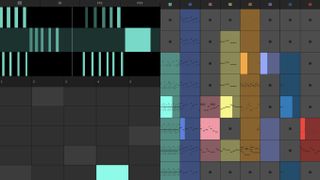
Ableton Note brings a streamlined take on Ableton’s popular desktop software to your iPad. This isn’t full Ableton Live. Instead, it’s best thought of as a musical sketchpad – a place in which to try out ideas wherever inspiration hits, which can then be worked up on a PC or Mac.
The interface makes it a cinch to work up loops fashioned from drum kits, synths and samples. An intuitive audition/confirm system lets you gradually build loops through adding new notes, and individual notes can be nudged if your timing is off.
Loops can become part of a greater composition by duplicating them, working up variations, and playing them together in the app’s grid view. It’s quality stuff, whether you’re a jobbing pro or someone who’d always fancied making music but felt intimidated by more complex and less welcoming apps.
- These are the best photo editing apps you can download right now
The best iPad art and design apps
Our favorite iPad apps for painting, sketching, drawing, CAD, pixel art, graphic design and animation.
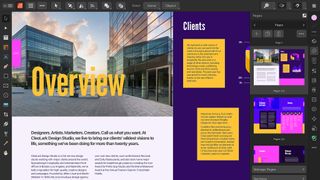
Affinity Publisher 2 for iPad ($19.99/£17.99/AU$30.99)
Affinity Publisher 2 for iPad joins Serif’s existing creative apps for iPad - Affinity Photo and Affinity Designer. Publisher, as its name might suggest, is all about layout design, giving you the means to create everything from a poster to a magazine, right on Apple’s tablet.
It’s full-fat desktop-grade fare. That means you’re not going to fashion a layout in a few clicks, but you do get fine-grained control over everything you work on – to a level that previously had only existed on a powerful PC or Mac. This means you can dig into complex typography along paths, work with master pages, import assets from other apps, export to a range of formats, and so much more.
At the price, it represents astonishing value for money, whether you’re a jobbing pro or someone who’d just like to try their hand at a pro-level layout app.
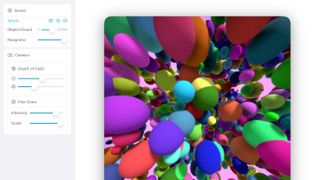
Acrylic ($1.99/£1.79/AU$2.99)
Acrylic is called a wallpaper engine by its creator – and there’s certainly scope within to fashion beautiful backgrounds for your iPad and other devices. But for our money, it’s just a really interesting app for working up abstract digital art.
The minimalist interface invites you to create a gradient or a scene. The former provides control over shades, subdivisions and points, and you can temporarily display a wireframe to better understand the mesh. Scenes instead have you extrude 3D shapes from a canvas and experiment with depth of field, color and film grain.
Anything you create is authentically saved to the app for subsequent experimentation. And any image can be exported in up to 4K, ready to use or expand on elsewhere.
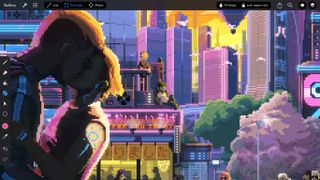
Pixaki 4 Pro ($26.99/£23.99/AU$41.99)
Pixaki provides iPad owners with a way to craft pixel art. The style originated by necessity during the 1970s and 1980s, and might seem obsolete in an era where individual pixels are impossible to see on a screen. But the aesthetic remains popular, perhaps because you instinctively know thought has gone into the placement of every dot.
With this latest revision, Pixaki feels modern. The interface is sleek, offering fast access to key tools and yet getting out of your way when you want to draw. More transforms would be nice (such as flip and rotate), but the shape, fill and brush tools are excellent, the layers system works well (and allows you to import reference images), and there’s a keyframe toolbar when you want to make artwork move.
Unsure? Check out the free ‘intro’ version, which limits canvas size, layers and animation frames, but is otherwise full-featured.

Zen Brush 3 ($4.99/£4.99/AU$7.99)
Zen Brush 3 is a next-generation painting app that focuses purely on the experience of working with East Asian ink brushes. Previous iterations of the app have been tactile and beautiful, but this release expands on the original premise in meaningful ways.
The new water feature provides scope for blending and bleeding, and a greatly expanded palette removes the severe limitations on hues that plagued earlier versions of the app. Plenty of templates enable you to augment your artwork with everything from paper to 3D objects.
Elsewhere, the brush action and ink emulation remain unsurpassed on iPad, making for a particularly beguiling experience when armed with an Apple Pencil. Great stuff for when you want to create Asian-influenced art, or just fancy something a bit different to relax with.

Voxel Max ($6.99/£6.99/AU$10.99)
Voxel Max is a pro-grade app for creating voxel art - essentially, pixel art in 3D. So instead of carefully placing pixels on a flat canvas, you plot cubes in a 256×256×256-pixel build area.
Although compatible with iPhone, the Voxel Max experience revels in the iPad’s extra screen acres. You get more room to view and manipulate your creation, and Apple Pencil support for when getting all painterly with shaped brushes (spheres; larger cubes) rather than adding individual cubes one at a time.
For professional illustrators, there are plenty of tools to dig into, including non-destructive transforms and face extrusions. But newcomers should find the app quite welcoming too, with its online help center and pre-built models to experiment with.

Procreate 5X ($9.99/£9.99/AU$14.99)
Procreate 5X is the latest iteration of the best painting app for iPad. Like its predecessors, this version has a minimal interface that gets out of your way while you work, yet packs a lot of power that’s placed within easy reach.
The existing and hugely impressive brush editor has now been augmented with a range of draw-on filters, including noise, blur, glitch and chromatic aberration. You can swiftly add a gradient map to any layer, auto-fill selections with color, precisely transform selections, and instantly create palettes from favorite snaps.
For newcomers, this is an immediate, intuitive proposition; and for long-time fans, Procreate 5X further pushes the app’s ambition and opens up yet more creative options. Either way, it’s a huge bargain at this low price.

Pastel (free + $4.99/£4.99/AU$7.99)
Pastel is an iPad app for any amateur or professional artist with a thing for color palettes. The second you open the app, you can peruse a collection of pre-loaded examples, which mix reference material (such as colors used on games systems) and hues that simply look great together.
Creating your own palettes is easy. Load a photo and Pastel will extract key colors – or you can start with a blank canvas. An existing palette can be edited at any point, using built-in color pickers. Furthermore, palettes can be exported to PDF, and individual values copied or dragged to other apps.
Pastel is every inch the modern, refined iPad app. It’s simple, usable, and makes excellent use of modern iPad conventions. Generously, you can also try it for free, adding up to 20 items before going 'unlimited' with a one-off IAP.

Linea Sketch (free or $0.99/99p/AU$1.49 per month)
Linea Sketch reasons that sketching on iPad shouldn’t require you to be inundated with too many features. This app therefore gets out of your way so you can get on and draw.
Tools sit at screen edges, making it a cinch to access colors, pen tools, and layers. You can import images to sketch over, work with grids and custom backgrounds, and record your masterpiece’s creation to export and show off on social media later.
With Apple Pencil, the app is especially lovely to use, with straightforward transform controls, responsive line thicknesses, and the superb ZipLine that turns wobbly scribbles into perfect polygons, just by having you pause for a second when you’re done.
Note that the free version is full-featured, merely watermarking exports and reminding you to support development - so you’ve got no excuse to not check it out.

Looom ($9.99/£9.99/AU$14.99)
Looom cleverly rethinks frame-based hand-drawn animation for iPad. Rather than aping desktop tools, it fully utilizes the touchscreen. Ideally, you draw with an Apple Pencil, and use your other hand to move between frames. The process feels fluid - we agree with the creator’s suggestion that it’s akin to playing an instrument rather than using software.
Although a Pencil is preferred, it’s possible to use a finger to paint. And either way, your creations are likely to resemble wobbly scribbles. But Looom is nonetheless a superb entry point for animators, due to its ease of use, and a useful sketchpad for veterans - not least when you consider you can run up to five layers, each with their own unique number of frames.
The lack of share options (such as GIF) is a pity, but SVG export to desktop software is at least provided for pros.

iOrnament Pro ($6.99/£6.99/AU$10.99)
iOrnament Pro resembles a hugely powerful customizable kaleidoscope. As you draw, the app repeats your strokes across the screen on the basis of rulesets you choose to define symmetry types. There’s a range of pen types and brushes, along with bling-like glitter effects; and if you don’t fancy going freehand, you can use geometric shapes or import a photo.
The basics are simple enough for a child, but iOrnament Pro’s toolset lets seasoned artists delve deeper. There’s a layers system, an option for wrapping your work around a sphere, and several export options, including the entire image, single tiles, and a time-lapse recording.
In some ways, iOrnament Pro is a curious beast. It’s not an image editor you necessarily need; but as everything from an experimental design tool to a relaxation aid, it’s one you may well want.

Imaengine Vector (free + $2.99/£2.99/AU$4.99)
Imaengine Vector is two apps in one. In its most basic form, it’s a photo filter app. Load a picture or use your iPad to take a photo, and you can select from a number of filters. Most of them are eye-popping, transforming your image to anything from ink sketch to abstract art.
That alone is worth the outlay, but tap the ‘editor’ button and Imaengine Vector transforms into a full editing package, enabling you to adjust every stroke, and add to the image with lines and shapes of your own.
The app’s interface is a touch esoteric, and would do better if it avoided shoving all the buttons right at the edge of the iPad’s display. But that’s the only major shortfall in this powerful app, which can produce some seriously arresting visuals.
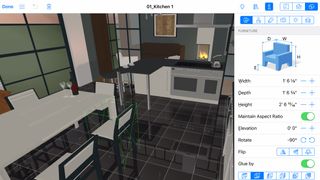
Live Home 3D (free + IAP)
Live Home 3D is for people who fancy partaking in some interior design. Whether you want to experiment with your own home, or design an entirely new one, there are plenty of tools here for doing so – in 2D and 3D alike.
Even for free, there’s loads to delve into, from creating bespoke floor plans to projecting your finished masterwork on to real-world surroundings in AR. Thousands of materials and models are available to deck your virtual home out so that it resembles the real thing.
There are two paid tiers: Standard ($9.99/£9.99/AU$14.99) removes watermarks and is flexible regarding import/export; Pro ($19.99/£19.99/AU$30.99) gives you more customization in terms of drawing, output quality, and light editing. In all versions, the app is powerful, usable, and entertaining.
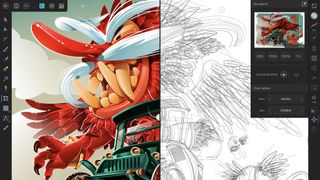
Affinity Designer (US$19.99/£19.99/AU$30.99)
Affinity Designer brings desktop-grade vector illustration to iPad. Its huge range of tools are ideally suited to anything from high-end illustrations through to interface design. Every stroke always remains editable, and you can zoom to an absurd degree, and never lose detail.
The app works nicely with Apple Pencil or your own digits, and has a smart gestural system where holding fingers on the screen mirrors desktop keyboard modifiers. Elsewhere, you can pinch layers to group them, or drag one layer on to another to create a mask.
This is an app you can get lost in – but in a good way. The more you use it, the more you realize its sheer scope. And it even shares a file format with Affinity Photo, so you can bounce documents between the two without losing anything.
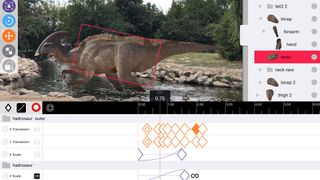
Core Animator ($5.99/£5.99/AU$9.99)
Core Animator is an app for creating motion graphics on your iPad. If you’ve ever seen Adobe Animate (formerly Flash), you’ll feel at home. If not, the app might take longer to get to grips with, but you’re helped along by built-in tutorials and Core Animator’s usable, logical interface.
The basics involve adding objects to a canvas and manipulating them at various ‘keyframes’ on the timeline. You can adjust each one’s position, rotation, scale, and opacity, and Core Animator deals with all the frames in between.
It’s worth noting there are no drawing tools, so you must import elements created elsewhere. The app also demands time and patience, but give it both and you can end up with superb results.

Concepts (free + various IAP)
Concepts is an advanced vector-based sketching and design app. Every stroke remains editable, and similar flexibility is evident elsewhere, with varied grids (dot; lined; isometric), definable gestures, and an adjustable interface.
With version 5, Concepts’ design revamp transformed the main toolbar into a space-efficient tool wheel, from which Copic swatches pleasingly explode when you switch colors. As such, the app’s a touch alien at first, and can be fiddly if you don’t have a Pencil.
But Concepts soon becomes natural and fluid in use, and it’s apparent the app’s been designed for touch, rather than a developer hammering desktop concepts into your iPad.
If you’re not a professional architect, illustrator or the like it might be overkill, but if you’re unsure, you can get a feel for the app for free. IAPs subsequently allow you to unlock shape guides, SVG and PDF export, infinite layers, and object packs.

Clip Studio Paint Ex for manga ($8.99/£6.99/AU$11.49 monthly)
Clip Studio Paint Ex for manga brings the popular PC desktop app for digital artists to the iPad. And we mean that almost literally – Clip Studio looks pretty much identical to the desktop release.
In one sense, this isn’t great news – menus, for example, are fiddly to access, but it does mean you get a feature-rich, powerful app. There are loads of brushes and tools, vector capabilities, effect lines and tones for comic art, and onion skinning for animations. It also takes full advantage of Pencil, so pro artists can be freed from the desktop, and work wherever they like.
The app could do with better export and desktop workflow integration, and even some fans might be irked by the subscription model. But Clip Studio’s features and quality mean most will muddle through the former issues and pay for the latter.

Stop Motion Studio Pro ($4.99/£4.99/AU$7.99)
Animation can be painstaking, whether doing it for your career or just for fun. Fortunately, Stop Motion Studio Pro streamlines the process, providing a sleek and efficient app for your next animated masterpiece.
It caters to various kinds of animation: you can use your iPad’s camera to capture a scene, import images or videos (which are broken down into stills), or use a remote app installed on an iPhone. Although most people will export raw footage to the likes of iMovie, Stop Motion Pro shoots for a full animation suite by including audio and title capabilities.
There are some snags. Moving frames requires an awkward copy/paste/delete workaround. Also, drawing tools are clumsy, making the app’s claim of being capable of rotoscoping a tad suspect. But as an affordable and broadly usable app for crafting animation, it fits the bill.
The best education apps for iPad
Our favorite iPad apps for learning something new – from astronomy to human history.

Codea ($14.99/£14.99/AU$22.99)
Codea wants you to use your iPad for creating things – specifically other iPad apps and games. Built around the Lua programming language, Codea is a code editor with a friendlier face than most – to change a color, you just tap and drag; if you get stuck, reference materials are built in. Once you’re done, press play and you can watch your code run, and interact with what you’ve made.
Although you can’t expect to fire up Codea and be troubling the App Store charts within a week, there are many examples you can mess around with, which help you understand the fundamentals of a game or 3D graphics.
If you’re still a bit suspicious that an app exists for creating other apps, do be mindful that there are already apps and games made with Codea available for download. So why not make one yourself?

Brian Cox's Wonders of Life ($0.99/£0.99/AU$1.49)
Brian Cox's Wonders of Life hints at the future of consumable media. At its core, this is an educational journey into over 30 creatures and their habitats. You learn how living things on Earth are interlinked, and the way in which everything is constructed from the same fundamental building blocks.
It’s the presentation, though, that sets the app apart. The main interface comprises sets of 3D scenes you can twirl and explore. Embedded within, you’ll find over a thousand high-res images, short videos narrated by Brian Cox and engaging essays.
The result is something that borrows from magazines, books, television and apps, successfully merging them all into something new. Especially on the larger screen of the iPad, the dazzling visuals and text alike all get a chance to shine.

Solar Walk 2 - Planet Explorer ($2.99/£2.99/AU$4.99)
Solar Walk 2 is a digital orrery. It offers a stylized 3D view of the solar system, and tapping on any planet or moon whisks you toward it within seconds, like you’re piloting a rocket from NASA’s dreams.
The view can be manipulated by standard iOS gestures, although this app is also really nice to just leave in a docked iPad so you can watch moons and planets orbit their parents.
When you want to science things up a bit, though, the app’s ready and willing. An interactive facts panel provides stats, graphs, and the means to crack open a planet to see what’s inside. Add some IAP and you can travel with famous space missions like Voyager 1. In all, it’s a cracking alternative to a real-world orrery – and a lot more portable and interactive, too!

Human Anatomy Atlas 2018 ($24.99/£23.99/AU$38.99)
Human Anatomy Atlas 2018 represents a leap forward for iPad education apps and digital textbooks alike. In short, it turns your iPad into an anatomy lab – and augmented reality extends this to nearby flat surfaces.
You can explore your virtual cadaver by region or system. Additionally, you can examine cross-sections, micro-anatomy (eyes; bone layers; touch receptors, and so on), and muscle actions. If you want to learn what makes you tick, it’s fascinating to spin a virtual body beneath your finger, and ‘dissect’ it by removing sections.
But the AR element is a real prize, giving you a captivating, slightly unnerving virtual body to explore. Ideal fodder for medical students, then, but great even for the simply curious. And although it’s pricey for the latter audience, the app’s often on sale, and has dropped as low as $0.99/£0.99/AU$1.49. Snap it up if you see it cheap.

LookUp ($2.99/£2.99/AU$4.49)
There are quite a few dictionary apps on iPad, and most of them don’t tend to stray much from paper-based tomes, save adding a search function. LookUp has a more colorful way of thinking, primarily with its entry screen. This features rows of illustrated cards, each of which houses an interesting word you can discover more about with a tap.
The app is elsewhere a mite more conventional – you can type in a word to confirm a spelling, and access its meaning, etymology, and Wikipedia entry.
The app’s lack of speed and customization means it likely won’t be a writer’s first port of call when working – but it is an interesting app for anyone fascinated by language, allowing you to explore words and their histories in rather more relaxed circumstances.

Redshift Pro (($17.99/£17.99/AU$27.99)
The ‘pro’ bit in Redshift Pro’s name is rather important, because this astronomy app is very much geared at the enthusiast. It dispenses with the gimmickry seen in some competing apps, and is instead packed with a ton of features, including an explorable planetarium, an observation planner and sky diary, 3D models of the planetary bodies, simulations, and even the means to control a telescope.
Although more workmanlike than pretty, the app does the business when you’re zooming through the heavens, on a 3D journey to a body of choice, or just lazily browsing whatever you’d be staring at in the night sky if your ceiling wasn’t in the way.
And if it all feels a bit rich, the developer has you covered with the slightly cut down – but still impressive – Redshift, for half the outlay.

Sky Guide ($2.99/£2.99/AU$4.49)
There are quite a few apps for virtual stargazing, but Sky Guide is the best of them on iPad. Like its rivals, the app allows you to search the heavens in real-time, providing details of constellations and satellites in your field of view (or, if you fancy, on the other side of the world).
Also, when outside during the daytime (at which point stars are inconveniently invisible to the naked eye), you can use augmented reality to map constellations on to a blue sky.
Indoors, it transforms into a kind of reference guide, offering further insight into distant heavenly bodies, and the means to view the sky at different points in history. What sets Sky Guide apart, though, is an effortless elegance. It's simply the nicest app of its kind to use, with a polish and refinement that cements its essential nature.

Earth Primer ($9.99/£9.99/AU$14.99)
When you're told you can control the forces of nature with your fingertips that probably puts you more in mind of a game than a book. And, in a sense, Earth Primer does gamify learning about our planet. You get a series of engaging and interactive explanatory pages, and a free-for-all sandbox that cleverly only unlocks its full riches when you've read the rest of the book.
Although ultimately designed for children, it's a treat for all ages, likely to plaster a grin across the face of anyone from 9 to 90 when a volcano erupts from their fingertips.

Journeys of Invention ($9.99/£9.99/AU$14.99)
Touch Press somewhat cornered the market in amazing iOS books with The Elements, but Journeys of Invention takes things a step further. In partnership with the Science Museum, it leads you through many of science's greatest discoveries, weaving them into a compelling mesh of stories.
Many objects can be explored in detail, and some are more fully interactive, such as the Enigma machine, which you can use to share coded messages with friends.
What's especially great is that none of this feels gimmicky. Instead, this app points towards the future of books, strong content being married to useful and engaging interactivity.
The best movie and entertainment apps for iPad
Our favorite iPad apps for having fun with your iPad, whether reading, watching TV, using Twitter or delving into interactive art.
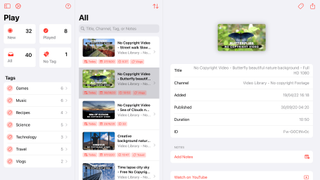
Save Videos Watch Later ($2.99/£2.49/AU$4.49)
Play: Save Videos Watch Later gives you a place to bookmark YouTube videos, so you can view them later – or dig into saved favorites. You might argue YouTube does this itself, but Play’s feature set goes beyond what YouTube offers.
On iPad, videos can be added to Play via drag and drop from the Subscriptions tab, sharing, Shortcuts, or copying and pasting URLs. The ability to assign tags lets you organize bookmarked videos, and iCloud sync means you can get at your collection on all your Apple devices.
With its sleek interface, Home screen widgets, easy to filter video list, and low one-off payment, Play is an excellent app to get more from YouTube by organizing what you’d like to watch and ensuring much-loved videos always remain within easy reach.

Book Track (free + $5.99/£4.99/AU$9.99)
Book Track is an app dedicated to helping you read more – whether you prefer paper tomes or those that exist in digital form on your iPad. Libraries can be imported via CSV or from GoodReads, or you can opt to start afresh by way of an online search or scanning book barcodes.
The app affords you great flexibility. Your library can be displayed as cover art or a text-based list. Items can be categorized, including the formation of a wish-list for items you don’t yet own. There are options for saving quotes and tracking loaned books.
Overall, Book Track is a great way to keep tabs on your collection, and even your reading progress through a statistics pane. On iPad, it shines, not least with the info-rich but beautifully designed three-pane view on the bigger 12.9-inch iPad Pro.

Infuse 7 ($0.99/79p/AU$1.49 per month)
Infuse 7 lets you play your digital video collection on your iPad – wherever said videos happen to be stored. Point the app at a cloud service or folders on a home network and it’ll go through your files, adding cover art and descriptions. When you watch, you can pull down subtitles with ease.
The app supports a wide range of formats, and optional Trakt connectivity enables you to sync your watch history, submit ratings, and sound off about what you’ve viewed. The revamped home screen makes for a more custom experience than before, with user-defined lists based on genre, age and ratings.
For what you get, it’s good value – and there are annual and lifetime discounts if you’re a fan. Not sure about splashing out? You can always run the free version, which removes cloud service support and sync, but nonetheless excels for watching videos stored on your local network.

EōN by Jean-Michel Jarre ($8.99/£8.99/AU$13.99)
EōN by Jean-Michel Jarre exists in a similar territory to the algorithmically generated audio apps released on iPad by Brian Eno and Peter Chilvers. Only instead of an endless river of generative ambient audio, you get something akin to an infinite Jarre remix.
This all works better than you might think, with Jarre’s trademark synth washes, electronic beats, and flickering riffs dancing about in a mix that never repeats itself. Although there are quite clearly defined ‘tracks’ of sorts, they’re different every time you fire up the app.
On iPad in particular, the visual component gets a chance to shine. On the larger display, the resulting effect is a little like a desktop Jarre concert – and unlimited iterations for the price of a single new album seems like quite the bargain.

Tayasui Color 2 ($1.99/£1.99/AU$2.99)
Tayasui Color 2 is a rare iPad coloring app, in that it’s properly premium and doesn’t delve into the murky world of subscriptions. That means it’s more limited than its contemporaries – you get just 18 illustrations – but you’re not forking out for something you may only dip into on occasion.
The app has other benefits, too, not least a beautiful design that makes it feel like the most tactile offering on the platform. The illustrations sit within a flip book of virtual stiff card pages. As you color, sound effects mimic real-world tools, which is especially mesmerizing if you’re using a stylus.
There is one minor issue, in the illustrations not scaling as well as they might when you zoom in – they get a bit blurry. But otherwise, this is a wonderful premium take on iPad coloring.

Reeder 4 ($4.99/£4.99/AU$7.99)
Reeder 4 is a premium RSS client. You subscribe to website feeds, which can be browsed individually or as a whole, ensuring you never miss an article from favorite sources.
Although you can opt to view the original web pages, you’re better off with Reeder’s own reader, which removes cruft, leaving you with just text and images. For sites that only provide synopses, entire articles can be loaded with a touch of a button. There’s also a ‘Bionic Reading’ mode can also be invoked, emboldening specific letters in words to slow you down, so you take in more of the text.
Despite the odd flub (a default theme that very much needs the ‘increase contrast’ option on; finicky animations), Reeder remains ahead of the pack. It’s a must-buy if you want a better way to take in news and other articles on your iPad.

David Bowie is… ($9.99/£9.99/AU$14.99)
David Bowie is… takes 2013’s blockbuster Bowie exhibition and stuffs it inside of your iPad as an AR experience.
Curated by theme rather than chronologically, the exhibition is a set of interactive scenes, ‘projected’ onto your desktop. Optional narration by Gary Oldman adds backstory as you examine lyrics, costumes and videos, exploring the life of a music icon.
On iPad, David Bowie is… works especially well. The screen’s squarer aspect ratio makes examining content less awkward than on iPhone, and the larger display lets everything shine. The only thing that might give you pause is the price, but for far less than a ticket to the original exhibition, you get unlimited access to all the goodies – including dozens of songs and videos – without having to peer over other people’s shoulders.
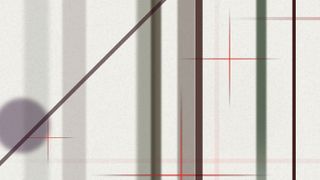
Bloom: 10 Worlds ($7.99/£7.99/AU$12.99)
Bloom: 10 Worlds is the follow-up to 2008’s Bloom, which never made it to iPad. That app had you tap the screen to simultaneously play notes and create spots of color. The former looped and slowly evolved; the latter disappeared into the background like ripples in a pond.
10 Worlds expands this premise out from a ‘single’ into a full album. There are 10 takes on the format to enjoy, each with its own visuals and audio. The visuals in particular have been significantly improved from the original Bloom, replacing that app’s hard geometric forms with a more painterly approach.
However, it’s the intriguing mix of instrument, album, and art that still shines through. The result is an essential addition to iPad, perfectly complementing existing Eno/Chilvers collaborations Scape and Reflection.

Shepard Fairey AR - Damaged (US$4.99/£4.99/AU$7.99)
Shepard Fairey AR - Damaged takes a warehouse-sized art exhibit and transforms it into a virtual space. This means instead of getting a digital book, where you swipe between stills, you instead experience the context and atmospherics of the original show, dragging the screen to move, or actually walking around in AR, adjusting your view on the basis of where you hold your iPad.
Fairey – creator of the iconic ‘Hope’ image of Barack Obama – is on fine form here, exploring issues relating to social media, celebrity, and the notion of constructing your own reality. Optionally, his narrative can accompany your journey around his work, adding extra insight. But however you check out Damaged, it proves itself to be the finest example of a virtual gallery on mobile, looking to the future rather than the past.

Tweetbot 5 (US$4.99/£4.99/AU$7.99)
Tweetbot 5 is a premium Twitter client. Unlike Twitter’s own client, which is determined to present tweets as it sees fit, Tweetbot lists tweets in order, omits ads, and doesn’t clutter up your mentions feed with notifications about retweets and likes. There’s a night mode, for tweeting in the dark, iCloud sync across devices for keeping your place, and nice sound effects that make the app feel alive.
On iPad, the app of course supports Split View and Slide Over, but it also has its own built-in column view. This means if you’re the kind of person who lives on Twitter, you can, for example, simultaneously scroll through your feed in the main pane, while chatting with people via direct messages in another. Top stuff for power users – or anyone who wants to avoid social network noise.
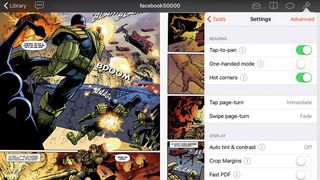
Chunky Comic Reader (free or $3.99/£3.99/AU$4.49)
There's a miniature revolution taking place in digital comics. Echoing the music industry some years ago, more publishers are cottoning on to readers very much liking DRM-free content. With that in mind, you now need a decent iPad reader for your PDFs and CBRs, rather than whatever iffy reading experience is welded to a storefront.
Chunky is the best comic-reader on iPad. The interface is simple but customisable. If you want rid of transitions, they're gone. Tinted pages can be brightened. And smart upscaling makes low-res comics look good.
Paying the one-off 'pro' IAP enables you to connect to Mac or Windows shared folders or FTP. Downloading comics then takes seconds, and the app will happily bring over folders full of images and convert them on-the-fly into readable digital publications.
The best health, diet, and exercise apps for iPad
Our favorite iPad apps for cooking, relaxing, de-stressing and keeping fit.
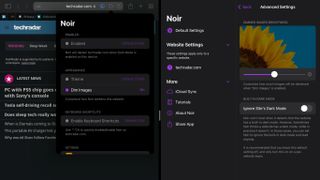
Noir ($2.99/£2.49/AU$4.49)
Noir is a Safari extension that wants to protect your eyes when you browse the internet at night – or just don’t want to be dazzled during the day. It does this by adding a dark mode to any website you visit when iPadOS 15’s Dark Mode is active, or by enabling you to trigger Noir whenever you like.
The extension comes with several built-in styles, along with further options to tweak what you see, for example by dimming images on the page. Wisely, it lets you apply specific settings to individual websites, if one doesn’t happen to play well with the defaults.
This sense of polish and the smattering of control set Noir apart from the competition. Sure, there are free alternatives to Noir on the App Store, but the quality gulf between these products is like day and night.

Portal (free + various IAP)
Portal is an ambient noise/relaxation app that wants to take your mind somewhere else - and in a more literal sense than most. Instead of merely providing audio, Portal has you virtually travel to a range of serene locations. Each is a combination of video loop and 3D soundscape - a window to a tiny world designed to help you focus, relax, and sleep.
The free app gives you a slice of the full experience, with six portals to jump through. Pay the IAP and that number rises to over 40. On the larger screen of an iPad - and with headphones on - the experience is hypnotic.
It’s configurable, too, enabling you to overlay a clock, run a focus timer, and display the task you’re trying to concentrate on. The only thing you’ll wish when it’s running is that your iPad’s screen was the size of an actual window.
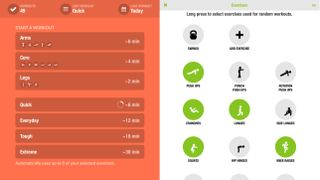
Streaks Workout ($3.99/£3.99/AU$5.99)
Streaks Workout is a personal trainer squeezed into your iPad. But unlike many of its contemporaries, Streaks doesn’t make assumptions about your skill level and environment. You don’t need any equipment, and the app is flexible enough to fit around your capabilities and interests.
To rapidly kick things off, you can select exercises to use within random workouts, and choose from one of four timers. These range from the reasonable six-minute Quick to the arduous half-hour Extreme. As you exercise, the app records how you do, building up a log of your efforts.
At any point, you can create your own custom exercises, making the app truly yours. And with data syncing across the cloud, there’s no excuse for not working up a sweat, since Streaks can always be with you on iPad, iPhone, Apple TV, and Apple Watch.

Cosm ($1.99/£1.99/AU$2.99)
Cosm is a mash-up of mental wellness aid and ambient instrument. Fire up a new session, prod the screen, and a calming note will play. Tap a few more times, and you’ll soon realize you’ve composed a custom loop to serenade you into the infinite.
So far, so Brian Eno’s Bloom – but Cosm takes things further. You get control over tuning, volume, and instrumentation. Most importantly, your compositions can be saved, whereupon the app encourages you to add a written note about how you feel.
The idea is to create a kind of journal that’s driven in part by the compositions you make – or at least to make compositions that give you a boost when you later return to them. Whether or not you’re a fan of Eno’s iPad apps, Cosm is well worth investigating.

Paprika ($4.99/£4.99/AU$7.99)
Paprika is ideal for people who live in the kitchen. Whereas other cooking apps are content to serve up some recipes and a shopping list, Paprika is a full-fledged scrapbook and meal planner you can use for every aspect of your culinary world.
Recipes can be added manually or snipped from favorite websites. Anything added to the app can be adjusted, if you decide you’ve figured out a way to improve the dish or preparation methods, or fancy adding some photos. Beyond that, there’s an ingredients tracker, meal planner (with Calendar integration), menu creator, and the means to print recipes.
It’s not as visually flashy as the likes of Kitchen Stories and Tasty, but Paprika feels like the best bet for anyone whose iPad spends almost as much time in the kitchen as they do.
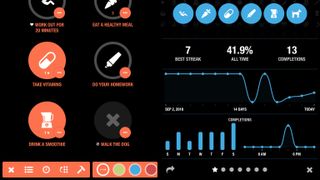
Streaks (US$4.99/£4.99/AU$7.99)
Streaks is habit-forming – in a good way. It’s effectively a to-do manager that focuses on what you want to do in your life – and bad habits you want to eradicate.
To get started, you create tasks, assign icons, and define durations. The app’s flexible regarding how often tasks should be done; and you can create time-based ones (whereupon the app temporarily becomes a timer), those that interact with Apple’s Health app, and ‘negative’ ones you don’t want to ‘complete’. Streaks then tracks your progress in handy graph form.
The app’s iPhone origins are obvious, not least in the main display that’s optimized for six tasks and therefore looks comical on iPad. But it’s nonetheless great to have this superb app in native form on Apple’s tablet, and iCloud sync ensures any changes you make are accessible across all your Apple gear.
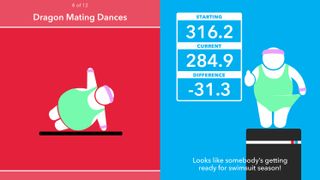
CARROT Fit ($3.99/£3.99/AU$4.49)
CARROT Fit is the answer if a more sensible exercise app just isn’t doing it for you. Like CARROT Weather, this fitness tool is helmed by a snarky, sarcastic AI. Here, she comes across like the deranged offspring of HAL 9000 and a personal trainer. To wit, she’ll threaten, ridicule and bribe you, in order to “prevent your body from blimping up.”
The actual exercise bit is, broadly speaking, conventional, in that you partake in recognizable routines. But even there, CARROT Fit has a very distinct character, referring to push-ups as ‘Kowtows to Cthulhu,’ and subtly renaming the seven-minute workout ‘7 Minutes in Hell.’ Still, you’ll likely need some humor when sitting on the floor in a sweaty heap after a few minutes of exercise, and CARROT Fit has that over its straight-laced contemporaries.
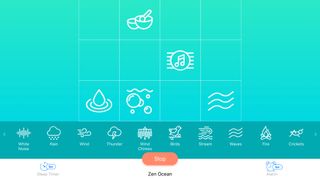
White Noise+ (free + US$2.99/£2.99/AU$4.49 IAP)
White Noise+ is a sound machine designed to reduce distractions by way of ambient noise. Many apps in this space are a bit new age and flowery, and quite a few are, frankly, rubbish. Fortunately, White Noise+ is none of those things, instead providing a thoroughly modern, tactile take on noise generation.
The app’s based around a grid akin to smart drums in GarageBand. Here, you get 16 slots, into which you drag icons that represent different sounds. Those toward the top play more loudly, and those toward the right have more complex loops. Your mixes can be saved, and sleep timers and alarms are available if you want to use White Noise+ for meditation sessions – or for waking you up should you doze off.
You get a handful of sounds to play with for free, but the full set requires a one-off IAP. Given the quality of the app, it’s well worth the outlay.
The best kids apps for iPad
Our favorite iPad apps, learning tools and games for toddlers and children.

Pok Pok Playroom (free + IAP)
Pok Pok Playroom is a set of handcrafted toys aimed at young children between the ages of two and six. Echoing real-world play, each of the app’s individual playrooms is designed to foster experimentation and exploration. This is an app about discovery, not stress – there are no timers, and all play is open-ended.
From a visual standpoint, Pok Pok Playroom is a joy, with colorful shapes reminiscent of sleek cut-outs. The interface is suitable for youngsters, whether they’re painting a picture, playing with musical shapes and objects, or exploring rooms in a doll house or a virtual town that features rivers, emergency vehicles and little ducks you can drag about.
The subscription might grate, but the production’s wholesome nature makes it worth checking out with your children – at least for a month or two.
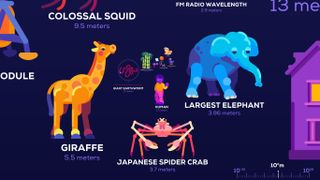
Universe in a Nutshell ($2.99/£2.99/AU$4.99)
Universe in a Nutshell is one of those educational apps aimed at kids that’s nonetheless a joy to explore as a grown-up. It’s designed to help you discover your place in the universe - at least in terms of your relative size to a bunch of other objects. This occurs by way of you pinching to zoom in and out, all the way up to the size of the observable universe and way down to the Planck length.
Each object within the app is illustrated in a bright, vibrant, cartoonish style. Tap on one and you’ll get basic facts about what you’re looking at, giving you insight on everything from dinosaurs to black holes. In all, over 250 objects are included, in what amounts to the most joyfully tactile size comparison chart you’re ever likely to see.

Thinkrolls Space ($3.99/£3.99/AU$5.99)
Thinkrolls Space continues the great tradition of the Thinkrolls series, giving young children a play experience that marries dexterity tests and puzzle-solving logic. Here, over 200 mazes are set across seven unique planets, and the player is tasked with getting trundling protagonists to the exit. As ever, there are all kinds of hazards in the way.
Given that this game is set in space, there’s a sci-fi/fantasy vibe to proceedings. Plasma fields, teleporters, and vanishing rainbow bridges must be dealt with, along with a cast of oddball aliens, including sleeping robots and cheese monsters that helpfully devour tunnels of moon cheese.
This iPad app has no timers, no IAP, and its challenges are specifically designed for different skill levels, making it a good bet for families with kids of different ages. Top stuff all round, then. (Pun intended.)

Pango Musical March ($2.99/£2.99/AU$4.99)
Pango Musical March is arguably not at the educational end of the children’s apps on our list. However, it is a lot of fun for any kid with a musical bent – or who just loves watching colorful cartoon critters do their bidding.
On selecting a musical style (or all four at once), a bar with instruments appears at the foot of the screen. Drag one up to an empty spot and a band member starts to play and march. Add to the musical menagerie for a suitably disciplined slice of marching band goodness – or a barely listenable cacophony.
With no ads, time limits, nor competitive elements, this is a playful and relaxing app for younger children to experiment with, and the visuals look superb on the iPad’s large display.

Sago Mini Village ($2.99/£2.99/AU$4.49)
Sago Mini Village was reportedly inspired by Minecraft, but designed very much with young children in mind. Therefore, you’re still building your own world from blocks, but these are a bit chunkier than Minecraft’s, and this is a resolutely solo experience.
It’s colorful fare, as you’d expect from a Sago Mini title, set in a fantasy land populated by gnomes. The more buildings that are constructed, the more gnomes move in – and then they start exploring and interacting. There are plenty of entertaining animations and fun surprises throughout.
With offline support and no IAPs, Sago Mini Village is ideal fodder for any young child who loves to build, during those times when it’s not possible to litter your real-world environment with piles of plastic bricks.

Pango Paper Color ($2.99/£2.99/AU$4.49)
Pango Paper Color is akin to coloring in a living world of origami. Across four scenes, including a forest and a farm, you see objects constructed before your very eyes. You then tap to add colors, whereupon the objects spring to life. Everything looks superb on the iPad’s large display.
Although primarily designed for children, Pango Paper Color is a really nice experience for all kinds of iPad user. Fans of animation will appreciate the effort that’s gone into it; or if you just want something different to relax with, it fits the bill.
For kids, though, this one should really hit home. They can learn to mix colors, photograph and share their scene; and when they’re done coloring, they can fold up all that virtual paper – and then start all over again!

Sizzle & Stew ($2.99/£2.99/AU$4.49)
Sizzle & Stew shows why young children – along with sloths and llamas – need supervision in the kitchen. Your kid helps the furry duo concoct culinary ‘delights’ that would give a Michelin Star chef chills.
Creating dishes involves partaking in all manner of havoc in the kitchen. Want to microwave a carrot into oblivion? Go for it. Stick broccoli in the oven until it’s unrecognizable? Sure. In the washing machine, too? That’s even tastier. (Just as well, then, that these beasts will eat anything.)
With its absurdist, open-ended, risk-free nature, Sizzle & Stew is bound to appeal to kids. Even better, on iPad a simultaneous two-player split-screen mode has room to breathe, so you can pit your skills against your kid’s – shortly before finding out neither of you’s likely to get a TV chef gig.

Toca Life: Office ($2.99/£2.99/AU$4.49)
Toca Life: Office gives your kids a chance to play out what they imagine their working parents get up to all day – albeit in exciting environments likely more colorful and interesting than the real thing.
For young children, there’s plenty of fun to be had simply in moving the little figures about, and poking backgrounds to see what happens. For slightly older kids, exploration can prove rewarding in other ways – there’s a secret exit from the jail, a working copy machine in the office, and a cafe where you can merrily experiment with what’s on the menu.
Neatly, there’s even a recording feature, so kids can get creative and act out a scene, which can then be shared with friends. In all, this is another superb Toca Boca creation that ticks all the right boxes.

Bandimal ($3.99/£3.99/AU$5.99)
Bandimal is a music toy for the rest of us. Actually, its App Store description states it’s a music composer for kids, but ignore that because Bandimal is great fun for everyone.
It offers three slots into which you swipe an animal. A quick tap opens a dotted grid, on to which you assign notes by prodding the dots. These trigger loops when the playhead moves over them, and there are no wrong choices.
There’s a drum track too, along with some basic effects and a speed dial. And as you’re composing, your little menagerie will bop to the beat, with animation that’s so much fun it’s sure to make any cartoonists in the vicinity a touch envious.
You might avoid Bandimal because you’re not a musician. Don’t. This app’s only to be avoided if you hate fun.

Zen Studio (free + IAP)
Zen Studio is a unique, beautifully conceived painting and coloring app. Instead of giving you a blank canvas for free-form scribbling, Zen Studio opts for a triangular grid. Tap spaces and they fill with your selected color as a note plays. This combination of coloring and ad-hoc melody proves very relaxing – for children and adults alike.
In its free version, this is an entertaining app, but it’s worth grabbing the main $2.99/£2.99/AU$4.99 IAP. This lets you save unlimited drawings (rather than just eight), and unlocks white paint, which acts as an eraser on compositions with white backgrounds.
It also provides access to a slew of tutorials. These have you build up a picture by coloring inside stencils, which even a two-year-old should be able to cope with – and then subsequently scrawl over when the stencils disappear.

Little Digits ($2.99/£2.99/AU$4.49)
Little Digits is a new spin on finger counting, making use of the iPad’s large screen, and its ability to recognize loads of fingers pressing down at once.
The app’s most basic mode responds to how many fingers are touching the screen. Use a single digit, and the app chirps ONE! while a grinning one-shaped monster jigs about. Add another finger and the one is replaced by a furry two. You get the idea.
Beyond this, the app offers some basic training in number ordering, addition and subtraction, making it a great learning tool for young children.
But the smartest feature may well be multiple language support and recording. This means you can use the app to learn to count in anything from French to Swedish, and record custom prompts if your own language isn’t supported.

Metamorphabet ($3.99/£3.99/AU$5.99)
You're probably dead inside if you sit down with Metamorphabet and it doesn't raise a smile — doubly so if you use it alongside a tiny human. The app takes you through all the letters of the alphabet, which contort and animate into all kinds of shapes. It suitably starts with A, which when prodded grows antlers, transforms into an arch, and then goes for an amble. It's adorable.
The app's surreal, playful nature never lets up, and any doubts you might have regarding certain scenes — such as floaty clouds representing 'daydream' in a manner that doesn't really work — evaporate when you see tiny fingers and thumbs carefully pawing at the iPad's glass while young eyes remain utterly transfixed.

Toca Nature ($2.99/£2.99/AU$4.49)
On opening Toca Nature, you find yourself staring at a slab of land floating in the void. After selecting relevant icons, a drag of a finger is all it takes to raise mountains or dig deep gullies for rivers and lakes.
Finishing touches to your tiny landscape can then be made by tapping to plant trees. Wait for a bit and a little ecosystem takes shape, deers darting about glades, and fish swimming in the water. Using the magnifying glass, you can zoom into and explore this little world and feed its various inhabitants.
Although designed primarily for kids, Toca Nature is a genuinely enjoyable experience whatever your age.
The one big negative is that it starts from scratch every time — some save states would be nice, so each family member could have their own space to tend to and explore. Still, blank canvases keep everything fresh, and building a tiny nature reserve never really gets old.
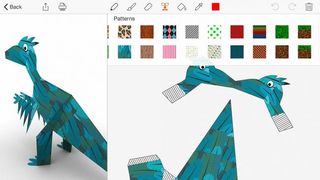
Foldify Dinosaurs ($3.99/£3.99/AU$5.99)
We're big fans of the Foldify apps, which enable people to fashion and customise little 3D characters on an iPad, before printing them out and making them for real. This mix of digital painting, sharing (models can be browsed, uploaded and rated) and crafting a physical object is exciting in a world where people spend so much time glued to virtual content on screens.
But it's Foldify Dinosaurs that makes this list because, well, dinosaurs. Who wouldn't be thrilled at the prospect of making a magenta T-Rex with a natty moustache? Should that person exist, we don't want to meet them.
The best music and audio apps for iPad
Our favorite iPad apps for sampling, being a DJ, making music and listening to podcasts.
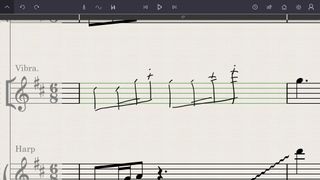
StaffPad ($89.99/£79.99/AU$139.99)
StaffPad reimagines traditional music composition on an iPad, transforming the screen into a living intelligent canvas. You’ll need an Apple Pencil, and also to spend a little time learning the notation StaffPad expects. But once you grasp that, lines and flicks are instantly transformed into beautifully typeset notation that can be edited, printed and shared.
The app also includes a powerful playback engine. Impressive banks of samples combined with high-quality effects can almost trick you into thinking you’re sitting before an orchestra as your work is performed.
Other niceties – such as the means to import audio and to export your compositions as MIDI for working on in other music apps – round out a quality product that’s worth the admittedly (for iPad apps, at least) hefty price tag.
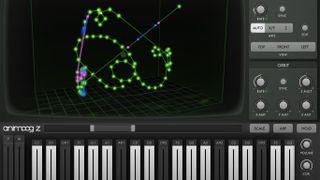
Animoog Z Synthesizer (free + $19.99/£17.99/AU$30.99)
Animoog Z is the follow-up to hit iPad synth app Animoog. Like its predecessor, this combines gorgeous Moog sounds with a touch-friendly interface that lets you use gestures to add expression to your compositions. The presets are excellent, and even if you don’t pay for the full version, there’s fun to be had.
With that IAP, though, a world of audio experimentation opens up. You can dig into screens full of dials and effects, sculpting your own sonic universes and navigating through three axes of sound.
It looks superb, visualizing audio in captivating fashion. And with support for MIDI and AUv3, Animoog Z can be used as part of the wider iPad audio ecosystem, shifting it from stunning standalone to a vital component of a modern home synth set-up.

Cs: Music Player ($2.99/£2.99/AU$4.49)
Cs: Music Player is a throwback, in the best possible way. It’s like a modern incarnation of Apple’s Music app – before the Apple Music service sidelined your own music collection. Cs dispenses with radio stations and algorithmic feeds, instead concentrating solely on your music library.
This works best on iPad in ‘grid view’, with cover artwork filling the display. But you can opt for ‘list view’ instead, and adjust the sort order of artists, songs, albums and playlists. When listening, a swipe on the mini player skips between tracks; and if you want to go fully old-school, you can even block Apple Music tracks stored in the cloud and only display music stored on your iPad. For the money, Cs is a first-rate buy, however you use it.
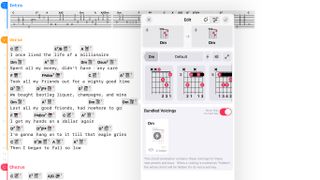
SongKit ($9.99/£9.99/AU$14.99)
SongKit is a powerful notepad for songwriters. When jotting down something from scratch, you can quickly combine lyrics and chord charts/tab, along with defining your song’s structure. Alternatively, you can share a song you’ve found in Safari to SongKit and the app will attempt to format it. Mostly, minimal editing is required to tidy up SongKit’s efforts.
That alone would sell the app for many people, but SongKit is blessed with many more useful features. Songs can be transposed in an instant. As you’re writing, the app can suggest chords; and when you’re learning or gigging, autoscroll can ensure you get through a song without forgetting the words and chords.
There’s also export functionality, so you can share your next chart-topper as a beautifully rendered PDF. It’s all quite involved, but SongKit is a rare app that never plays a bum note.
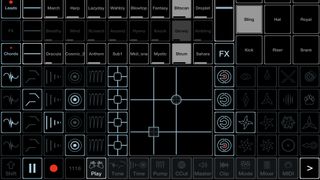
Jamm Pro ($9.99/£9.99/AU$14.99)
Jamm Pro sits apart from other music-making apps on iPad. Whereas most ape real-world kit, Jamm Pro is a unique instrument in and of itself - and a hugely powerful one for working with samples.
It initially looks like a bewildering grid of buttons, and you’re best off starting with one of the included sound sets, so you can slowly master the app. As you poke around, you’ll discover the app’s mix of raw power and tactile controls that unleash loads of potential, whether you’re scribbling across the screen to manipulate samples, or sculpting a live performance.
This isn’t an easy app to grasp – the lack of immediacy may be off-putting, and even a help overlay doesn’t stop your initial time with the app feeling overwhelming. But stick with it, and Jamm Pro will reveal itself as a deep, powerful, touch-first music-making tool.

AudioKit Hey Metronome ($1.99/£1.99/AU$2.99)
AudioKit Hey Metronome is a bit different from most iPad apps for music-making, in that it’s designed to help you work on songs using real instruments. Specifically – as its name likely suggests – it’s all about keeping you in time, as you write something new or work on nailing an existing song.
However, there’s also the ‘hey’ bit; like Siri, this is a metronome you can bark orders at. That might seem an odd idea, but it’s great to have a hands-free metronome when you’re holding your instrument.
This app offers more than just 4/4 beeps, too. Along with a range of time signatures and drum sounds, you can construct playlists that echo your current set – or select from a range of popular tracks, when you fancy jamming along to someone else’s tune.

AudioKit L7 – Live Looper ($19.99/£19.99/AU$30.99)
AudioKit L7 – Live Looper is an audio recorder inspired by Roland’s Boss RC-505 Loop Station. You record short snippets of audio that continue to loop, and gradually build a soundscape – a technique often used by beatboxers and guitarists to impressive effect.
As an iPad app, AudioKit L7 is robbed of some portability – you won’t hold an iPad like a mic and make mouth sounds into it. However, what you do get is a bigger surface on which to tinker with any noises you record.
The app also enables you to mix in imported audio and add effects, resulting in a playground for creativity. It’s a different take on music making, but one that’s ideal for jobbing musicians looking for new ways to be inspired, or newcomers after a user-friendly entry point.

AudioKit FM Player 2 ($3.99/£3.99/AU$5.99)
AudioKit FM Player 2 is an open-source iPad synth that’ll beam you back to the 1980s. Its many and varied presets are based on over 150 samples, and bathe your ears in classic sounds from the likes of Yamaha’s DX7 and TX81Z.
A slew of knobs to twiddle, along with an arpeggiator and 16-step sequencer, give you plenty of scope for shaping sound. This is the kind of synth where you can merrily hold down a single key, fiddle with settings, and suddenly realize half an hour’s zoomed by.
The app plays nicely with the iPadOS music ecosystem, too. It will work with MIDI keyboards, and also other music apps – in fact, AUv3 support means the entire interface can be loaded into GarageBand, whenever you fancy getting your Kraftwerk on.
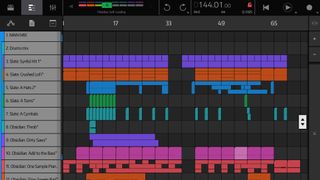
NanoStudio 2 ($24.99/£23.99/AU$38.99)
NanoStudio 2 is the successor to NanoStudio, an iPhone app that let musicians bash out songs on iPhones before GarageBand for iOS was a twinkle in Apple’s eye. Now less ‘nano’ (being iPad-only), the follow-up is a remarkably powerful tool for recording, sampling, editing, and mixing.
The app was six years in the making – and it shows. Built-in synth Obsidian is among the best on iOS, and is hugely versatile in the noises it can create. Drum machine Slate adds rhythm, and if that’s not enough, NanoStudio 2 lets you effortlessly incorporate Audio Units like Poison-202 and Minimoog Model D.
There is an electronic bent to NanoStudio 2, so it’s not ideally suited to people into more traditional sounds. Otherwise, this usable, feature-rich music production environment is a must-have for iPad musicians.
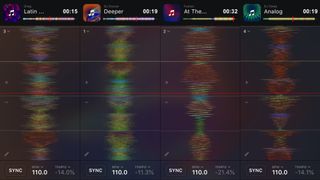
djay (free + $4.99/£4.49/AU$7.49 monthly)
djay is a full-featured DJ solution for iOS. You get a two-deck mode with crossfader, looping, and effects for free, but splash out on the pro subscription and you’re instantly equipped with enough DJ power to keep you spinning decks into the small hours.
You get a two-deck view with flanking libraries – and a four-deck view when two isn’t enough. There’s VJ mixing when you fancy adding some video, support for a slew of controllers, and over 1GB of samples you can fire off to stamp your personal style over whatever’s blasting from the local sound system.
Naturally, it’s total overkill (albeit fun total overkill) for the typical home user; but if you’re a pro DJ armed with an external controller, it may well be enough to chuck all that traditional kit on eBay.
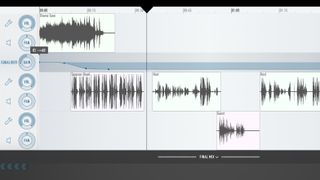
Ferrite Recording Studio (free or $28.99/£28.99/AU$46.99)
Ferrite Recording Studio at first looks like a souped-up voice memos app, but beneath lies a powerful multi-track editor, so if you’re armed with an iPad, the app and some time, you can create your own podcast.
For free, there are limitations: an hour of recording, ten-minute projects and three tracks. Go Pro and Ferrite gives desktop editors a run for their money: 32 tracks, projects up to a day long, and recording time limited only by the space on your iPad.
The pro version adds further handy tools for improving recordings, such as effects, auto-leveling, MP3 chapters and dead air removal, bt the most impressive thing is how this all comes together. Ferrite might be powerful, but it’s also extremely usable. It therefore comes highly recommended if you’ve any interest in multi-track voice recording projects.
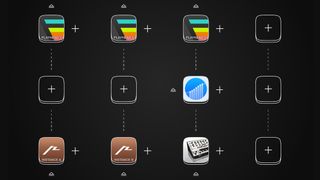
Audiobus 3 ($9.99/£9.99/AU$14.99)
There are so many amazing music-making apps on iPad that it’s hard to choose between them. With Audiobus 3, you sort of don’t have to, because it acts as a kind of behind-the-scenes plumbing.
Virtual cabling might not sound sexy, but it hugely boosts creative potential. You can send live audio or MIDI data between apps and through effects, mix the various channels, and then send the entire output to the likes of GarageBand.
Much of these features are new to Audiobus 3, and this latest update also adds Audio Unit support, enabling you to open some synths and effects directly in the app.
With support for over 900 iOS products in all, Audiobus 3 is an essential buy for anyone serious about creating music on an iPad.

Poison-202 ($9.99/£9.99/AU$14.99)
So, you’ve picked up an iPad synth to compose music, play live, or bound about like a maniac, pretending you're on stage at Glastonbury. Fortunately, Poison-202 is ideal for all such sets of circumstances.
The moody black and red graphic design is very 1990s, but it's Poison-202's sounds that hurl you back to the halcyon days of electronic music. Aficionados of The Prodigy, Chemical Brothers and Orbital will be overjoyed at the familiar (and brilliant) sounds you can conjure up simply by selecting presets and prodding a few keys.
And if you're not satisfied by the creator's (frankly awesome) sound design smarts (in which case, we glare at you with the menace of a thousand Keith Flints), all manner of sliders and dials enable you to create your own wall-wobbling bass and ear-searing leads.
There are iPad synths that have more ambition, and many are more authentic to classic hardware; but few are more fun.
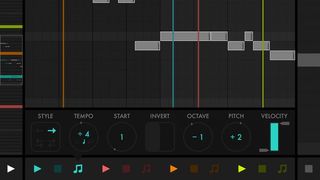
Fugue Machine ($9.99/£9.99/AU$14.99)
This music app is inspired by layered composition techniques used in some classical music. You tap out notes on a piano roll, and can then have up to four playheads simultaneously interpret your notes, each using unique speeds, directions and transpositions. For the amateur, Fugue Machine is intuitive and mesmerising, not least because of how easy it is to create something that sounds gorgeous.
For pros, it's a must-have, not least due to MIDI output support for driving external software. It took us mere seconds to have Fugue Machine working with Animoog's voices, and the result ruined our productivity for an entire morning.
(Unless you count composing beautiful music when you should be doing something else as 'being productive'. In which case, we salute you.)
The best office and writing apps for iPad
Our favorite iPad apps for writing, email, editing PDFs, spreadsheets, coding and file management.
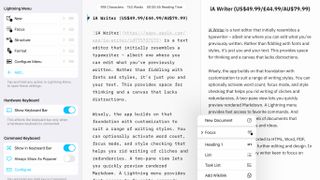
iA Writer ($49.99/£44.99/AU$79.99)
iA Writer is a text editor that initially resembles a typewriter – albeit one where you can edit what you’ve previously written. Rather than fiddling with fonts and styles, it’s just you and your text. This provides space for thinking and a canvas that lacks distractions.
Wisely, the app builds on that foundation with customization to suit a range of writing styles. You can optionally activate word count, focus mode, and style checking that helps you rid writing of cliches and redundancies. A two-pane view lets you quickly preview rendered Markdown. A Lightning menu provides fast access to favorite commands. And wikilinks let you build a web of documents that connect multiple thoughts and ideas.
Finished copy can be exported to HTML, Word, PDF, WordPress or Medium for further editing and design. In all, it’s a must-have for any writer keen to focus on what really matters.
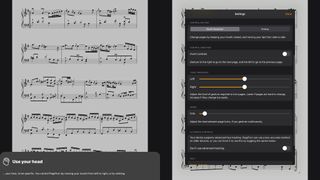
PageTurn Universal (free + $3.99/£3.49/AU$5.99)
PageTurn Universal is a curious beast: a PDF document reader that doesn’t want you using your hands to switch pages – instead, you use your face. Specifically, you move your lips from side to side to turn the page, or wink in a somewhat exaggerated manner.
You might question why you’d ever want to do such a thing, but it’s really handy for musicians who don’t want to remove their hands from instruments when working with sheet music or guitar tab. A moment’s thought should suggest other use-cases as well.
Smartly, the app is configurable. You can invert the control direction and adjust the turn threshold and time between page turns. The only downside: get used to the app and you’ll end up gurning at a PDF if you accidentally open it in the wrong app.

Moleskine Journey ($4.99/£3.99/AU$6.49 per month)
Moleskine Journey is an organizational tool pitched at “creative minds,” “independent workers,” and “free spirits.” It blends productivity tools and wellness, looking after you whether you’re at work or trying to achieve personal goals.
The app can pull in events from your Apple calendar data, and augment them with imagery, links, and PDFs. A task-based to-do list is included, along with a project manager, for grouping complex requirements by topic. Under My Day, you see your day’s schedule, along with a food diary, and a custom habits log.
On iPad, Moleskine Journey isn’t quite as streamlined as on iPhone, in part due to a dual-pane view. But the flip-side of that is gaining access to a lot more information at once. Regardless, it’s an interesting take on personal organization that successfully caters to work and play.
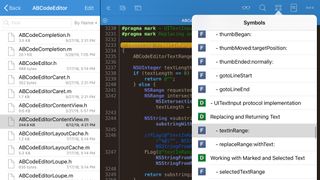
Textastic Code Editor 8 ($9.99/£9.99/AU$14.99)
Textastic is a text editor for coders. It’s tasteful and minimal, yet packed full of features for optimizing workflow.
When using just an iPad, the custom keyboard row provides fast access to a range of characters. If you’ve got a physical keyboard, you can configure keyboard shortcuts for important actions. Fonts can be customized, and new themes selected.
The built-in file transfer manager enables you to access documents stored remotely; and although Textastic cannot be used as a Files location, you can get at local content via On My iPad. Want to go old school? Try printing off your code on paper.
As ever, there are limitations to an iPad coding editor, meaning you’re unlikely to create web pages or apps from scratch using the app, but it’s ideal for making edits when on the move – or on the sofa.

Cardhop ($3.99/£3.99/AU$5.99)
Cardhop reimagines the Contacts app – in a manner that makes it far more usable and useful. It uses existing iCloud data (and can integrate other address books), but rethinks how you get to data and actions.
A powerful search field utilizes natural language. This can be used to get at data that’s otherwise buried deep – ‘phone John’ or ‘FaceTime Jane’ – or to rapidly add new contacts by typing in a few of their details prior to tapping a button.
When browsing, notes are always accessible – handy if you use that field. There’s a tab specifically for birthdays, and another for recently accessed contacts – and that syncs across iCloud. Also, tap a piece of data in a card, and an action (like a call or email) isn’t immediately triggered – instead, you get a pop-up with options. Every detail feels considered and polished.
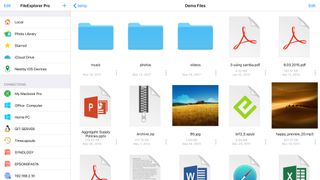
FE File Explorer Pro ($4.99/£4.99/AU$7.99)
FE File Explorer Pro plugs a hole in iPad file management – namely, getting at things that aren’t stored on your iPad or on iCloud. The usable, Apple-like interface makes it a cinch to connect to, explore, and preview or download your files, whether they’re on a PC or Mac, a network drive, or on remote cloud services other than Apple’s.
There’s drag-and-drop awareness, the means to flag files as favorites, and password support if you want your documents locked down. Perhaps best of all for people who work a lot on their iPads, FE File Explorer Pro integrates directly into Apple’s Files. Activate it as a location, and Apple’s app then gains seamless access to a huge range of storage options that are otherwise out of reach. Top stuff.
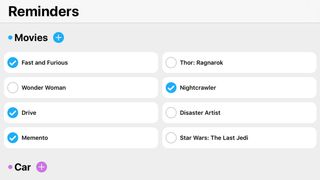
Memento: Modern Reminders ($2.99/£2.99/AU$4.99)
Memento: Modern Reminders is an alternative to the Apple Reminders app. It uses the same database, meaning you can at any point switch between the two apps; the main reason for splashing out some cash on Memento is speed – the app just makes it much easier to do stuff.
For example, when creating or editing a reminder, a smart keyboard row gives you speedy access to time and location alerts. The former provides useful options like ‘this evening’ and ‘tomorrow morning’.
Beyond that, there’s a Reminders feed that shows everything in a single scrolling pane, a tab for reminders with time alerts (‘For You’), powerful notifications management, and a visual design that looks far more like something Apple would create than Apple’s own app.

PDF Expert by Readdle ($9.99/£9.99/AU$14.99)
On the Mac, PDF Expert by Readdle is a friendly, efficient, usable PDF editor. If anything, the app’s often even better on iPad.
You can grab PDFs from iCloud or Dropbox. Pages can be rearranged by drag-and-drop, and you can add or extract pages with a few taps. Adding pages from another document sadly remains beyond the app, but you can merge two PDFs in its file manager.
As a reader, PDF Expert fares well, ably dealing with large PDFs, and the text-to-speech mode can read documents at a speed of your choosing. Similarly, the app makes short work of annotations, document signing, and outline editing.
Buy the ‘Edit PDF’ IAP ($9.99/£9.99/AU$14.99 on top of the original price) and you can directly update text, redact passages, and replace images. You’re obviously a little limited by a document’s existing fonts and layout, but this functionality is great if you spot a glaring error while checking a vital PDF on your iPad.
The best iPad photo and video editing apps
Our favorite iPad apps for shooting and editing photos and videos and adding filters.

LumaFusion ($29.99/£25.99/AU$46.99)
LumaFusion plugs a Final Cut Pro-shaped gap in the mobile app ecosystem, providing desktop-quality video editing on your iPad. You get six video/audio tracks and a further six audio-only tracks, along with a slew of transitions. The interface on iPad is flexible and fluid, making it a cinch to edit 4K footage on the go. And when you’re back at your desk, you can opt to place your preview on an external display.
The app is packed with audio and visual effects, along with a robust titler. It understands modern pro workflows, with version 3 adding support for third-party plug-ins, ProRes and direct editing from external USB-C drives. The last of those is vital with the increasing size of media files and the inability to expand internal iPad storage. In all, LumaFusion is superb and has a bargain price-tag for a desktop-grade product.

Halide ($11.99/£11.99/AU$19.49 per year)
Halide has long been known as a first-rate iPhone camera app. It combines a refined, intuitive interface with high-end features, which should please photographers wanting to get more out of their iPhone’s camera. On iPad, it does much the same – but this isn’t just a blown-up iPhone app.
The design has been rethought for the bigger screen, placing key controls near to your thumbs. A manual focus strip sits along the bottom edge, but with a large swipe area. An optional Pro View shrinks the viewfinder to sit within your field of vision.
Naturally, using the app won’t stop you from being seen as one of those people who shoots photos with a tablet. But when your camera app is this good, you won’t care – especially if you’ve got a recent iPad Pro, which can do surprisingly fancy macro-like tricks.
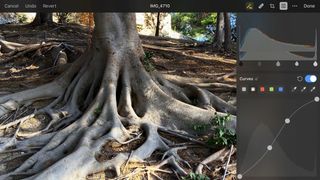
Pixelmator Photo ($4.99/£4.99/AU$7.99)
Pixelmator Photo is an iPad app designed to make your photos better. Its machine learning button, trained on 20 million pro photos, corrects lighting, exposure and shadows with a tap. The results are pleasing and natural compared to the over-saturated fake-looking fare produced by rival apps.
Film-like filters, together with a sidebar of buttons and sliders, let you unlock your creative and experimental side, and the tools within the sidebar are befitting of pricey desktop-grade software.
But here, too, efficiency is key. There’s direct integration with Files and Photos, and edits are saved in non-destructive fashion, so they can later be reverted. Batch editing lets you edit an entire photoshoot with just a few taps. And pictures can be resized during export.
Even if you only use the machine learning button, Pixelmator Photo’s low price makes it a steal. But once you’ve delved into the app’s other controls, you’ll be hooked.

Darkroom (free or $9.99/£9.99/AU$14.99)
Darkroom is a photo editor for iPad. On a device that’s not exactly short of photo editors, that might not excite you, but Darkroom differentiates itself from the crowd.
Open the app and it immediately presents your existing images. Tap one and you’re ready to edit. Tap a tool and a sidebar slides in, providing fast access to a superb range of tools for cropping and making adjustments. Throw some IAP at Darkroom, and these expand into even more professional territory by way of curves and color-correction tools.
None of that probably sounds all that different, but Darkroom’s no-nonsense approach, sleek interface and deep integration with iOS/iPadOS set it apart. It’s user-friendly and straightforward, yet powerful, and feels like something Apple at its very best might have created itself.
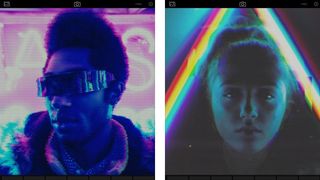
Glitch Art Studio (free + $4.99/£4.99/AU$7.99 IAP)
Glitch Art Studio is an effects app that aims to make even dull photos and videos look interesting. The filters are based around glitches and animated distortion, and can be edited to the point you can barely tell what the subject was.
Depending on whether you’re in it for speed or control, you can delve into presets or a bunch of individual menus respectively. Either way, you’ll end up concocting something resembling the display of a barely working old television, or some kind of deranged hallucinogenic episode.
On iPad, the larger canvas lets you fully appreciate the effects on offer – which are deeply impressive. If you’re fed up with filters that ape old paintings, use Glitch Studio to bring your creative photographic endeavors kicking and screaming into the (relatively) modern era.

VideoGrade (US$5.99/£5.99/AU$9.99)
VideoGrade is a color-grading app for video, giving you a taste of Hollywood on your iPad.
It’s a powerful app, but one that’s nonetheless straightforward to use. On launch, it finds all your videos. Select one and tools are displayed at the right-hand side of the screen. Open a menu, drag a slider, and changes are made instantly. Any tool used gets a handy green dot next to its name, helping you keep track of complex adjustments.
Filters (color changes, levels, pixelation and so on) are applied live, and a single tap fires up a full preview. Combinations of settings can be saved for later reuse. Also, the app’s various presets are available as a Photos extension. That means you needn’t even delve headlong into VideoGrade itself to apply some of its magic to your favorite videos.

Retrospecs (free or US$1.99/£1.99/AU$2.99)
Retrospecs is a photo filter app that revels in the history of computing and gaming. Rather than turning any photo or image into a tiny Picasso with a tap, it instead reimagines whatever you load as if it was on the screen of a Game Boy, Apple Mac or C64.
In fact, over 40 systems exist once you pay for the IAP (you can test Retrospecs for free with a small selection), and if that’s not enough, you can fashion your own custom emulations. For properly authentic retro output, you can edit dither modes, add glitch animations, tweak CRT effects and more.
Full support for video combined with some bonkers filters (PETSCII! Teletext!) adds scope for YouTube weirdness. But even if you only grab Retrospecs because you’ve always wondered what your face would look like on a NES, it’s worth the outlay.

Typorama (free + IAP)
Typorama is about adding text to your photos – or creating typographic designs from scratch – with a minimum of effort. Select a photo, flat color, or a stock image background, choose an output size, and you’re ready to get started.
Other apps in this space let you select fonts, but Typorama has you select designs. Enter some text, tap a design style, and what you typed is instantly transformed. If you’re not keen on what you see, tap the style again for variations.
You can add multiple type layers, and apply shadows and gradient effects to each one. There’s also a 3D rotation/perspective tool, and a selective eraser. Some features are locked in the free version and you must put up with watermarks, but there are various IAP available, including the ability to unlock everything for $5.99/£5.99/AU$9.99.
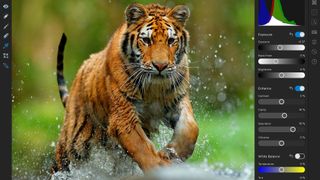
Affinity Photo ($19.99/£19.99/AU$30.99)
Affinity Photo extinguishes any lingering doubt regarding the iPad’s suitability for creative professionals. In short, it’s Serif’s impressive Mac/PC Photoshop rival, carefully reimagined for the touchscreen.
This is pro-level photo/image-editing fare, and you need the hardware to match – at least an iPad Air 2, but preferably an iPad Pro – but with the right kit, you get a huge range of features for image editing, creation and retouching.
The live filters and liquify tools are particularly impressive, responding to edits in real time. Working with a finger or Pencil is pleasingly tactile in a manner desktop equivalents can’t match.
RAW shooting/processing support, the ability to add fonts, layer isolation, and robust Files integration all cement Affinity Photo’s place among the iPad app greats. And if you become an expert, there’s even a ‘Show Touches’ option for making tutorials that other users can follow.

Artomaton - The Motion Painter (free + $2.99/£2.99/AU$4.49 IAP)
Artomaton - The Motion Painter is an ‘artificial intelligence artist’ – recreating photos as sketches and paintings. For free, you get a small selection of media, but pay a $2.99/£2.99/AU$4.49 IAP and you unlock the full range, including the arresting ‘Pointil’ (as in ‘lism’), scribbly crayons, and a lovely sketch/watercolor combo.
Unlike most competing apps, this one has many settings for adjusting properties, such as vignettes, stroke width, hatching angle, and color saturation.
It even works with video, and although it takes some time for Artomaton to draw all of the individual frames (just a 20-second clip will need close to 200), output with ‘Sketch&Water’ has a gorgeous scratchy hand-drawn quality.
For free, then, this is a great download; but grab that paid IAP for something really special.
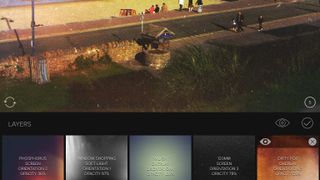
Mextures ($1.99/£1.99/AU$2.99)
The iPad may not be an ideal device for shooting photos, but its large screen makes it pretty great for editing them. And Mextures is perhaps the finest app around for anyone wanting to infuse their digital snaps with character by way of textures, grunge, and gradients.
The editing process is entirely non-destructive, with you building up effects by adding layers. In each case, textures, blend modes and rotation of scanned objects can be adjusted to suit, and you can experiment without fear of edits being ‘burned in’.
Particularly interesting combinations can be saved as ‘formulas’ and shared with the Mextures community – or you can speed along your own editing by downloading one of the many formulas that already exist.

VideoGrade ($5.99/£5.99/AU$9.99)
iPad video editors tend to have a bunch of effects and filters lurking within, but with VideoGrade you can go full-on Hollywood. On launch, the app helpfully rifles through your albums, making it easy to find your videos. Load one and you get access to a whopping 13 colour-grading and repair tools.
Despite the evident power VideoGrade offers, the interface is remarkably straightforward. Select a tool (such as Vibrance, Brightness or Tint), choose a setting, and drag to make a change. Drag up before moving your finger left or right to make subtler adjustments.
Smartly, any tool already used gets a little green dash beneath, and you can go back and change or remove edits at any point.
All filters are applied live to the currently shown frame, and you can also tap a button to view a preview of how your entire exported video will look. Want to compare your edit with the original video? Horizontal and vertical split-views are available at the tap of a button. Usefully, favorite filter combinations can be stored and reused, and videos can be queued rather than laboriously rendered individually.

Snapseed (free)
Apple's Photos app has editing capabilities, but they're not terribly exciting — especially when compared to Snapseed. Here, you select from a number of from a number of tools and filters, and proceed to pinch and swipe your way to a transformed image.
You get all the basics - cropping, rotation, healing brushes, and the like — but the filters are where you can get really creative.
There are blurs, photographic effects, and more extreme options like 'grunge' and 'grainy film', which can add plenty of atmosphere to your photographs. The vast majority of effects are tweakable, mostly by dragging up and down on the canvas to select a parameter and then horizontally to adjust its strength.
Brilliantly, the app records applied effects as separate layers, and each remains editable until you decide to save your image and work on something else. Combinations of edits can be saved as custom filters you can subsequently apply to more images with a tap.
The best productivity apps for iPad
Our favorite iPad apps for being productive with notes, to-dos, reminders, mind-mapping, calendars and calculators.
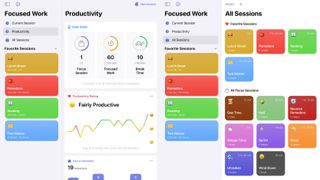
Pomodoro Timer - Focused Work (free or $4.99/£4.99/AU$7.99 per month)
Pomodoro Timer - Focused Work is a timer designed to boost productivity. At its most basic, you can fire off a timer to track work/break sprints. An optional floating timer can sit above other apps, meaning Focused Work doesn’t need a slot in Stage Manager.
Dig deeper and you can define and group custom focus sessions designed for your projects or goals (be they work, exercise or even meditation). This flexibility frees the app from the rigidity found in most pomodoro timers, and ensures it works specifically for you.
Built-in journaling, streaks and stats add layers of reflection, to help you improve things in the future. Focus filters and Siri shortcuts make the app a good iPadOS citizen. And if you’re still struggling to focus, you can have the app block distracting apps and websites while you work. In all, it’s the complete package.

Dashkit (free + IAP)
Dashkit comes across like a spiritual successor to the dearly departed classic Status Board. Like that app, Dashkit is all about personalized modules that feature the data that’s important to you, be that time, weather, web feeds, reminders, or charts from spreadsheets. There’s even scope to script modules yourself.
In a world where iPad widgets exist, you might wonder if there’s a need for Dashkit – and there is overlap. But Dashkit neatly keeps modules contained, they are simple to rearrange and re-edit, and you can have as many dashboards as you choose. It all feels very coherent and solid.
The dashboards look good and the app’s yearly subscription ($5.49/£4.99/AU$8.49) is reasonable for the value it provides; but Dashkit also lets you check out much of what it offers – including clocks, events, reminders, feeds and charts – entirely for free, so give it a go!
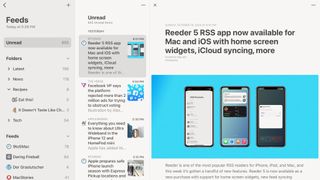
Reeder 5 ($4.99/£4.99/AU$7.99)
Reeder 5 aims to simplify and consolidate online reading. You can use the app to subscribe to website RSS feeds, thereby ensuring you never miss a headline from favorite sources. But also, you can send individual articles to Reeder from Safari to read later at your convenience.
The reading view itself is primarily concerned with efficiency. Rather than the original web page, you just get its content, and text settings can be adjusted to suit your needs. Should you wish to make reading more mindful, you can opt to activate Bionic Reading.
With support for a range of third-party RSS and read-later services, Reeder 5 is a beautifully designed and carefully considered one-stop-shop for all your online reading needs.
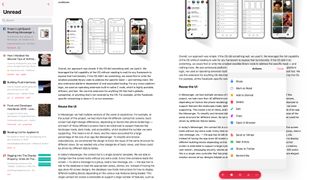
GoodLinks ($4.99/£4.99/AU$7.99)
GoodLinks is a read-later service. This means you save web pages to it, and the app extracts the text and images so you can browse them later in a distraction-free interface.
Rival apps Pocket and Instapaper are free, so what does GoodLinks do to justify its price tag? For a start, there are no ads and no accounts - everything syncs via iCloud. There are also no gated features, meaning you can from day one adjust typography, search your archive, and organize saved links.
The app also provides options for customization and tinkering. With Quick Save, you can avoid the standard save sheet that invites you to tag saved articles. Elsewhere, custom actions can immerse GoodLinks within Shortcuts automations.
These extras shift GoodLinks into territory beyond the more typical read-later app; but even if you only use it for the basics, GoodLinks is a solid choice.

Fantastical (free or $4.99/£4.99/AU$7.99 per month)
Fantastical’s developer reasons that a calendar is most helpful when it saves you time, rather than merely keeping track of where your time goes. Therefore, although this iPad app works with your existing calendar data (be that iCloud, Exchange or Google), it also offers various clever features to help speed things along.
In the main view, a scrolling ticker quickly gets you to events, past and present. Integrated weather forecasts ensure you won’t be caught unawares by a sudden shower – at your current locale or wherever an event is taking place.
There are also very ‘human’ touches – the way Fantastical can quickly interpret natural language while you create events; the means to offer event participants multiple time slots, and have the app figure out scheduling based on responses. In all, it amounts to a calendar that’s just as usable as Apple’s, but that helps you become far more productive.

1Blocker (free or $14.99/£14.99/AU$24.49 per year)
1Blocker removes the junk from web browsing – intrusive adverts and trackers, pop-ups, cookie notices, comments, social media inserts, and more. Install the app, and Safari is transformed – all the more important on a modern iPad where you get the desktop experience, which often comes with associated desktop cruft.
This is no one-size-fits-all solution. You can delve into seriously extensive settings, to toggle entire sets of tools (if, for example, you want comments on by default), or fine-tune things on a per-site basis, including defining custom rules regarding cookies and CSS blocks.
Originally a paid app, 1Blocker now requires a subscription for most of its features, but this comes with the benefit of monthly cloud rule updates and unlocks Mac support. If you hate paying a smallish outlay every year, there’s also a permanent premium IAP for $38.99/£37.99/AU$60.99.

Magpie (free + $2.99/£2.49/AU$4.49 per month)
Magpie is a mash-up of a notes app and a reminders system, designed for anyone who tends to remember things using photos. Of course, Apple’s own Notes app enables you to add imagery, but Magpie is fully optimized for the task.
In each named list, you can store unlimited numbers of notes. Photos are given prominence within the interface, but you can add text notes, along with a price, link, and location map. The layout of entries is excellent – a big plus over what Notes offers.
The lifetime purchase price of $35.99/£34.99/AU$55.99 is perhaps a touch ambitious, and it would be good to see exported notes match the app’s own gorgeous layouts. But Magpie nonetheless proves its worth for gift lists, and as a means for creative types to craft organized sets of visual reminders.

NordVPN (various IAP)
NordVPN is a VPN for your iPad. It secures and encrypts all internet traffic from your device, making it almost impossible for anyone else to decipher. Because you can connect to servers in specific countries, you can also use it to get around geographic restrictions.
This might all sound a bit suspicious, but VPNs are increasingly vital. They enable you to secure your connection on public Wi-Fi, and to access key websites and services that would otherwise be inaccessible – whether for political or commercial reasons.
NordVPN works very nicely on iPad. It’s easy to set things up, and a breeze to use. Connections tend to be reliable and only rarely noticeably slower than standard Wi-Fi. Do, though, subscribe via the NordVPN website rather than through the app, because you’ll get much better offers.

MindNode 6 (free + $14.99/£14.99/AU$22.99)
MindNode 6 is a desktop-quality mind-mapping tool. You can start with a blank canvas and a central thought, and add further nodes to connect. Or there’s a Quick Entry system that converts a bullet-point list to a mind map with a single tap.
Either way, once you get going, you’ll appreciate MindNode’s flexibility. The app makes good use of the touchscreen, allowing free-form diagram construction, or you can enforce stricter layouts by way of pre-defined positioning.
Should your mind map become complex, you can focus on one part, fading out the rest. Stickers, images, and color options ensure what you create can have added context and visual interest.
With iCloud support, your mind maps are available to other iOS devices as well. And a wide range of export formats means the ideas you get out of your head are easily shareable with others.

1Blocker X - Adblock ($4.99/£4.99/AU$7.99)
1Blocker X - Adblock blocks annoyances that may otherwise worsen your internet browsing experience on iPad.
Approve 1Blocker X in Settings, then configure it to block adverts, trackers, social widgets and more on a global basis. You can also hide specific web page elements, if they annoy or bother you. The net result is nippier browsing and more privacy.
If there are sites you’d like to support by not blocking their ads, 1Blocker makes this easy, too. You can manually define a whitelist in the app itself, or whitelist directly in Safari from the Share sheet.
With 1Blocker X being a premium app, and the indie creators prizing privacy, you can be sure this is the real deal. In short, it’s best-in-kind on iPad, and highly recommended.

Yoink (US$5.99/£5.99/AU$9.99)
Yoink is what’s known as a ‘shelf’ app – a kind of souped-up clipboard that can be used to collate files and content from disparate sources.
On iPad, Yoink proves especially useful, working in Split View and Slide Over, and making it a cinch to gather images, text, URLs and documents. You can import items as well, and even get at things you’ve stashed on other devices by way of iCloud sync.
With extended use, Yoink feels like an app that sweats the details. Copying and removing items depends on the status of a padlock icon. What you’ve saved in Yoink can be browsed in Apple’s Files app. You can edit text documents within Yoink, and interact with it via Siri. In all, it’s indispensable for power users – or anyone wanting a place to quickly store items before subsequently sharing them.
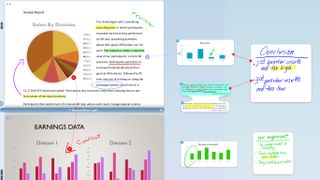
LiquidText PDF Reader (free + $29.99/£29.99/AU$46.99)
LiquidText PDF Reader has a misleading name. Although it is for reading and annotating PDFs, thinking it only capable of those things does the app a disservice. Really, you should consider it a hugely powerful product for dynamically gathering your thoughts, and quickly getting at important content within documents.
For free, you can import PDFs (along with Microsoft Office files), make highlights, and drag excerpts to a work area. Go pro and you can gather and link information across multiple files.
The app feels perfectly suited to the touchscreen. You can use Apple Pencil to scribble live ink lines that become dynamic links between documents. Gestures enable you to quickly collapse lengthy documents to read highlights, search results, or non-contiguous pages. For students, researchers, and anyone who wants to go beyond paper, LiquidText is a must-have.
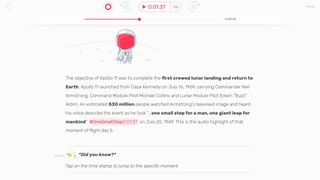
Noted (free + $0.99/79p/AU$1.49)
Noted cleverly combines an audio recorder and notepad. The rich text editor is like a simplified Pages, with predefined styles for headings and lists, image support, and a highlighter for drawing a reader’s attention to important bits.
That’s nothing new on iPad, but the way text and audio integrate is. During recordings, tapping the tag button adds an inline ‘#TimeTag’. Tapping this tag later will jump to the relevant point in the recording. This means you can spend more time in meetings and lectures listening, and later return to flesh out brief notes, adding context based on the audio.
Naturally, Noted’s own format is bespoke, but you can share notes with other users via iCloud. Otherwise, you can export audio to M4A format, and everything else to PDF. In all, then, an ideal productivity aid for a wide range of scenarios.

OmniOutliner 3 (from $9.99/£9.99/AU$14.99)
OmniOutliner 3 is a desktop-quality outlining tool that aims to bring structured writing to the masses.
It’s effectively two apps in one. Essentials is about quickly getting down and organizing ideas hierarchically. It’s quick and easy to add, promote and demote items (including with a physical keyboard, so you don’t have to keep reaching for the screen), and to shift rows around with drag and drop. The built-in search further elevates the app from more basic tools, filtering out non-matching rows so you only see only what’s relevant.
If your needs are greater, you can opt for Pro (US$39.99/£38.99/AU$62.99). This pushes the app towards word processing and spreadsheet territory, adding automation, styling options for document types (lists, book drafts, mathematical and so on) and section navigation from a sidebar. In either incarnation, the app is excellent, and a free two-week trial lets you switch between both versions to see which best suits.

Things 3 ($19.99/£19.99/AU$30.99)
Things 3 is a powerful task manager based around to-dos. Its ultimate aim is to ensure you get more done, and this is achieved by a smart and sleek workflow model that makes it simple to collect your thoughts, figure out your day, and plan far into the future.
The app can be as expansive or as simple as you need it to be. You can live in the Today and Upcoming views, working from basic to-dos, or add extra context and nested lists for more complex tasks. As of iOS 11, Things 3 added support for Split View and drag-and-drop, so you can drag links or emails right to a to-do.
This is the kind of app where you quickly wonder how you lived without it. And although it’s pricey when you buy it across iPad, iPhone and Mac, the time you’ll gain ensures it’s good value for money.
The best iPad weather and travel apps
Our favorite iPad apps for weather forecasts and planning a journey.
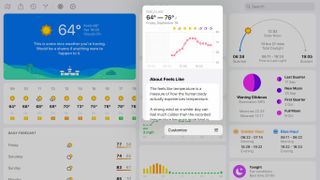
Carrot Weather (from $4.99/£4.99/AU$7.99 per month)
Carrot Weather has long been an app that’s married smart design, usability, immediacy and snark. Its forecasts are presented by a human-hating AI that delights in your misfortune, thereby creating that rarest of beasts: a weather app with personality. However, it’s a weather app beyond compare when you want to make it personal too.
You can customize almost every element of the interface, rearranging panels and adjusting how they look. On iPad, version 5’s three-pane view is fantastic, turning the device’s large screen into a weather station where you can scan every metric in an instant. Throw in widgets, games and notifications and you’ve got the best weather app on the system – and one that justifies the outlay if you subscribe.

Ventusky ($2.99/£2.99/AU$4.99)
Ventusky is a weather app that feels at home on iPad. Instead of filling your screen with stats and figures, it focuses on a beautifully animated map. Wind patterns streak across your display, helping to outline where weather’s coming from (and heading to).
The map is interactive. Layers can be switched between conditions, including temperature, rainfall, and cloud cover. You can pinch to zoom, shrinking the map to a tiny globe you can spin with a finger. (A 2D alternative exists in the settings.)
Drag the location forecast upward and you can dig down into further details: an hourly forecast; precipitation graphs; moon phases. It lacks the ‘Will I get soaked?’ imminent rainfall warning from Dark Sky, but as an exploratory large-screen iPad app, Ventusky is an excellent purchase.

WeatherPro for iPad (US$0.99/79p/AU$0.99)
WeatherPro for iPad is a weather app for people at the geekier end of the spectrum when it comes to meteorology and forecasts. It’s far from the prettiest app in the world, but it does pack a ton of information into your iPad’s display.
Set up several locations and their current conditions sit in a scrolling pane at the side of the screen. For the current selection, you can in the main pane check out a rainfall radar, along with the outlook for the coming week. And that’s way beyond a few symbols and temperature predictions – graphs and wiggly lines outline sun hours, precipitation, wind, and more.
For at-a-glance forecasting, you’re probably better off with Dark Sky. But for digging into the details, Weather Pro’s a good bet, especially considering the small outlay.

Poison Maps ($1.99/£1.99/AU$2.99)
Poison Maps is an app for finding points of interest – POIs – on maps. Hence: Poison Maps. If you were hoping it’d provide insight into finding toxins, you’re out of luck, but for restaurants, hotels, banks, tourist attractions, parking, shops, hospitals and so on, it does the job – millions of such POIs can be found by way of the efficient search function.
This might strike you as unnecessary, given the existence of the entirely free Google Maps, but Poison Maps has some trump cards. First, it has interesting and useful interface components, such as signs that clearly denote the distance to and direction of off-screen POIs.
Beyond static POIs, cycling and transport routes are built-in. Poison Maps also works offline, so should you find yourself in a new town and without a data connection, you’ll still have a fighting chance of finding the things you need.

Tinyclouds (US$1.99/£1.99/AU$2.99)
Tinyclouds is an adorable weather app. That’s perhaps a slightly odd description to use for something that’s usually utilitarian, but then Carrot Weather (elsewhere in this list) showcases how weather apps can have a character of their own, and Tinyclouds is certainly unique.
Select a location (you can store several within the app) and it provides a big temperature reading at the top of the sidebar, along with a forecast for the rest of the day and an outlook for the coming week. The rest of the screen is an ever-changing isometric city, with cars zipping about, its weather mirroring that of your chosen location.
The app does, admittedly, feel like a sketch – it could do with more detail, and at least a wider range of views. Still, as a simple, great-looking weather app for a docked and charging iPad, it’s well worth a couple of bucks.

Living Earth ($3.99/£3.99/AU$5.99)
As a combination clock and weather app, Living Earth works well across all iOS devices, but use it with an iPad in a stand and you've got something that'll make other clocks in the immediate vicinity green with envy.
As you might expect, your first job with the app is to define the cities you'd like to keep track of. At any point, you can then switch between them, updating the main clock and weather forecasts accordingly. Tap the weather and you can access an extended forecast for the week; tap the location and you get the current times and weather for your defined locations.
But it's the Earth that gets pride of place, taking up the bulk of the screen. It shows clouds by default, although weather geeks can instead choose colors denoting temperature, wind speed or humidity values. Then with a little swipe the globe rotates, neatly showing heavily populated locations during night time as lattices of artificial man-made light.

Google Maps (free)
You might argue that Google Maps is far better suited to a smartphone, but we reckon the king of mapping apps deserves a place on your iPad, too. Apple's own Maps app has improved, but Google still outsmarts its rival when it comes to public transport, finding local businesses, saving chunks of maps offline, and virtual tourism by way of Street View.
Google's 'OS within an OS' also affords a certain amount of cross-device sync when it comes to searches. We don't, however, recommend you strap your cellular iPad to your steering wheel and use Google Maps as a sat-nav replacement, unless you want to come across as some kind of nutcase.
Get daily insight, inspiration and deals in your inbox
Get the hottest deals available in your inbox plus news, reviews, opinion, analysis and more from the TechRadar team.
